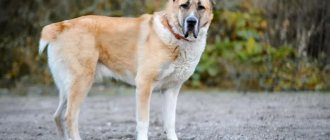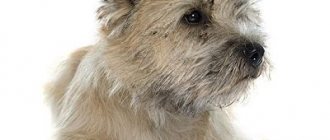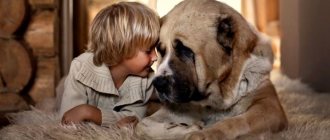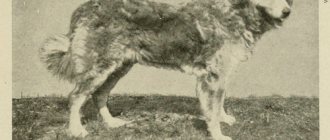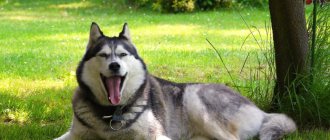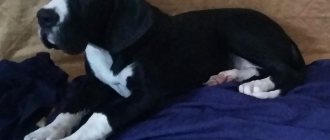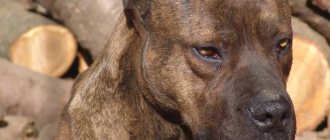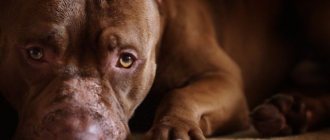History of the Dogo Argentino breed
Despite the fact that the breed is quite young and has existed for about a hundred years, its history began long before that, namely from the 16th century - the stage of the Spanish Conquest. Along with the desperate desire to seize the lands of the New World, the army “armed itself” with huge, ferocious dogs that kept the local population in fear because of their indomitable temper and rare bloodthirstiness. Basically, these animals represented a now defunct breed - the Cordoba fighting dog. However, among the imported ones there were also more peaceful Alan-Spanish bulldogs, which are common in their homeland to this day.
Dogo Argentino
It is worth noting that in those troubled times, fighting pits were popular, in which dogs fought to the last drop of blood. The city of Cordoba became the center of this business. Wanting to acquire new specimens that would be distinguished by extreme ferocity and endurance, the Spaniards crossed bull terriers and Alanos. This union gave birth to the Cordoba fighting dog, which later became a legend of bloodthirsty battles, since in most cases it snatched victory from its opponent with its teeth (and often literally). The breed practically did not participate in mating, since even dogs of different sexes showed hostility towards each other.
In the 18th century, an economic crisis reigned in the British Isles, and the state was forced to conduct active foreign trade. Among its partners was Argentina, which at that time had already changed the status of a Spanish colony to an independent confederation. Along with the goods, fighting dogs also came to the lands of Foggy Albion: staff bulls, bull terriers and the above-mentioned Cordovans. Unfortunately, the latter never took root in Europe. Over time, the fighting dogs of Cordoba disappeared completely, but before that they managed to make a significant contribution to the creation of a new breed. This is what the Dogo Argentino became.
Dogo Argentino (the second name of the dog) is the triumph of Antonio and Augustin Martinez, the sons of a wealthy landowner. Avid hunters used the Cordovan dog as an assistant - an extremely ferocious and bloodthirsty creature. At the same time, the young men could count on the participation of a maximum of two animals in baiting: due to their pugnacious nature, Cordoba’s fighting dogs did not want to gather in a pack and work as a team. The realization of this fact was the first bell that foreshadowed the appearance of the Dogo Argentino.
Dogo Argentino puppy
Work on creating the breed began in 1925, when Antonio had barely crossed the threshold of adulthood. The Martinez brothers set themselves a seemingly impossible task - to breed a dog with outstanding physical characteristics, excellent instincts and an attractive exterior. At the same time, it must have a balanced character, which does not imply aggression towards humans and other dogs.
Wanting to create a solid foundation for the new breed, Antonio and Augustin purchased ten Cordoban females - not as angry as males - and began to breed them with dogs in which they saw the desired qualities: speed, hunting instincts, height and sense of smell. Worthy breeds for mating include the Dogue de Bordeaux, the English Pointer, the Irish Wolfhound and the Great Pyrenees. It is worth noting that long before the positive result of his canine experiment, Antonio formulated the first breed standard, based on his own vision.
The brothers received tremendous support from their father, who hired people to care for the dogs while his sons were away from home. In addition, friends also showed interest in the new breed, who often fed the animals and made voluntary financial contributions. Everyone wanted to acquire a representative of a new hunting breed that could work in the company of its relatives and would not show excessive ferocity towards them.
For thirty years, Antonio and Augustin polished the exterior of the “Argentine”. At the same time, two branches of the breed were formed: the Araucana (from crossing with the Dogue de Bordeaux) and the Guarani (offspring from the Irish wolfhound). However, the prototype of the modern Dogo Argentino was a hybrid of two lines, so they have not survived in their pure form to this day.
Dogo Argentino with cropped ears
The death of Antonio Martinez while hunting in the mid-20th century brought chaos to the selection of the breed. Most breeders began uncontrollably crossing dogs, which significantly spoiled the geno- and phenotype of the Dogo Argentino. Only Augustine managed to return the process of dog breeding to its previous course. By the way, he was also involved in popularizing the breed. Martinez Jr. worked at the Ministry of Foreign Affairs and presented the ambassadors with an unusual but very valuable gift - Dogo Argentino puppies. The man believed that this kind of presentation is one of the most effective ways to glorify dogs throughout the world.
And so it happened: already in May 1964, the breed was officially registered by representatives of the Canine Federation of Argentina. Nine years later, the international organization FCI recognized the Dogo Argentino breed standard. At the same time, the breed gained popularity in European countries, mostly thanks to Otto Schimf. The Austrian dog handler was fascinated by the dogs' proud posture and played an important role in their spread throughout European territory.
Today, the Dogo Argentino is the only officially registered breed of the “Silver Country”. Its representatives combine the best qualities of their ancestors: courage, hunting instincts, flair, strength, size - and all this is in harmony with the playfulness and good-natured nature of the animals. However, the latter features are still questionable in some countries of the world. Thus, Ireland, New Zealand, Australia and Great Britain prohibit the breeding of Dogo Argentinos, since this breed is considered one of the most dangerous in the world. This is not true: dogs do not show ferocity towards humans and do not take part in dog fights due to the lack of aggression towards their tailed relatives.
Origin, history
With Dogo Argentino everything is clear and understandable. Dog handlers and historians do not put forward numerous hypotheses about their origin. The history of this breed naturally moves along one line. Breeding of the breed began in 1920. The world should be grateful to Dr. Antonio Nores Martinez for the appearance of the dog. An ambitious 18-year-old boy had the idea of creating a dog that would do an excellent job of hunting big game.
The will to win, courage, psychological stability and excellent physical data - the progenitor of the future breed should have possessed such data. The fighting dogs of Cordoba, which were obtained by mixing 4 breeds: Spanish mastiff, bulldog, boxer, bull terrier, fit these characteristics.
Crossing the fighting dog with other breeds gave the Dogo Argentino the features that we recognize in them today:
- great stature from the Great Dane;
- white color and endurance from the Great Pyrenees;
- power from the Dogue de Bordeaux;
- speed from the Irish Wolfhound;
- impeccable flair from an English pointer.
National recognition of the breed took place in 1964, and international recognition 9 years later in 1973. Her “journey” within group 2 in the ICF classification deserves attention. Initially, she was assigned to the 2nd group Molossae, but Argentine dog handlers insisted that she join the number of hounds. Later the breed was returned to Molosser again.
Appearance of the Dogo Argentino
Dogo Argentino and Donkey
Dogo Argentinos are large breeds. These animals are built very proportionally and have a tightly built physique. The muscles have clear contours that are noticeable even under the dog’s skin.
According to the FCI standard, males should reach a height of about 62-68 cm. For Dogo Argentino females, other parameters are defined - 60-65 cm. If we talk about the dog’s body weight, it varies between 40-55 kg.
Head and skull
The powerful and strong head of the animal is distinguished by the almost complete absence of subcutaneous fat, which is “compensated” by the predominance of muscles and bones. There are no sharp corners or deep depressions. The intersection of the lines of the muzzle and forehead is noted. The massive skull appears convex due to the developed muscles of the jaws and neck. The zygomatic arches are shifted from its apex, thereby forming a small depression in the temple area. The central and occipital parts of the skull are poorly defined.
Muzzle
The Dogo Argentino's muzzle is distinguished by consistent proportions: its length is not much greater than its height. The transition from the forehead to the nose is slightly pronounced, while the muzzle itself tapers slightly towards the end. A slightly arched top line is a distinctive feature of all representatives of the breed. The Dogo Argentino's nose is raised and gives a slight curve to the muzzle. It has wide open nostrils and black pigmentation. The dog’s lips also have the latter characteristic – short, moderately fleshy, with free edges.
Dogo Argentino muzzle
Ears
The appearance of the Dogo Argentino's ears depends on whether they are cropped or not. The only common feature is a high seating position. Cropped ears have the shape of a triangle, and their length is no more than half the length of uncropped ears (flat, wide, with rounded ends). At the same time, the latter can rise slightly when the Great Dane is angry or alarmed by something. Both cropped and undocked ears are spaced quite widely apart.
Eyes
Great Danes at an exhibition
Almond-shaped eyes have hazel or dark pigmentation. A black eyelid rim is desirable, but its absence is not considered a defect. The eyes are spaced widely apart and set very deep.
Jaws and teeth
The Dogo Argentino's jaws are positioned relative to each other so that they form a scissor bite, but a straight bite is also possible. Smooth and large teeth with uniform arches “sit” firmly in the gums. The breed standard requires a complete dental formula.
Neck
The thick neck of the Great Dane is characterized by a pronounced scruff and lack of dewlap. Folds are visible on the throat.
Frame
Has a rectangular format. The muscular, wide back extends into a developed croup, the width of which coincides with the width of the chest. The latter provides significant tidal volume due to its size and structure. The belly does not sag.
Tail
Dogo Argentino from the back
The long tail of the Dogo Argentino is saber-shaped and quite wide. Together with the upper line of the body, it forms an acute angle of 45 degrees. When walking and walking, the dog holds its tail at the level of its back or slightly higher.
Forelegs
They are distinguished by a developed musculoskeletal system. The shoulders are distinguished by moderate muscle relief. The animal's elbows are tightly pressed to the ribs and turned toward the back. The vertically positioned forearms turn into long wrists, and these, in turn, into flat metacarpus. Round paws have crowded powerful toes.
Hind limbs
Their slight inclination, strength and muscularity determine the dog's good drive and characteristic gait. Strong hips are connected to the joints at an angle of 100 degrees. They are not much longer than the animal's muscular legs. The metatarsal bones are oval in shape and located at right angles. The hind feet are not as large as the front feet, but the toes are shaped in a similar manner. It is worth noting that dewclaws are removed in most cases.
Movement style
Every step of the Dogo Argentino demonstrates confidence and agility. It is quite measured, but becomes more sweeping when the dog moves to a trot. The gallop perfectly emphasizes the natural strength of the animal. Balanced, harmonious, self-possessed - this is how one can describe the movements of a Great Dane.
Coat
The length of the guard hair does not exceed 2 cm. The density of the coat is determined by the climatic conditions in which the dog lives. In southern specimens, the skin is visible through the coat, while northern representatives of the breed are the happy owners of thick wool, often with undercoat.
Color
The Dogo Argentino is characterized by a white color. A black spot near the eyes or ear of the animal is acceptable, but a pure color without points is still preferable.
Dogo Argentino with black spot and pure white
Possible defects
Breed defects include:
- gait that does not meet the standard;
- weakened pigmentation of the eyes and nose;
- uneven skin color;
- unstable nervous system;
- keeled or barrel-shaped chest;
- incomplete dental formula;
- weak muscular system;
- eversion or inversion of the eyelids;
- flattened ribs;
- long shins;
- flakiness.
Any deviation from the breed standard is regarded as a defect.
If we talk about disqualifying defects, the most common among them in Dogo Argentino are:
- the presence of points in places atypical for the standard;
- aggressive or cowardly behavior;
- uneven development of the jaws;
- excessively long guard hair;
- lack of nasal pigmentation;
- blue eye pigmentation;
- heterochromia;
- cryptorchidism;
- deafness.
Standard
The standard for this breed has been adjusted several times. For example, previously it was possible to have some teeth missing. Now it is necessary to have a mouth with a full set of teeth.
The animal is tall, but the Dogo Argentino cannot be called a giant. Its height at the withers is about 66 cm, if we are talking about a male. Females are shorter - about 60 cm. The weight of males is 40-46 kg. Female - 38-42 kg.
The dog looks proportionally built. There is a slight hint of stockiness. Cast body. All the elastic muscles that form the relief muscle frame are clearly visible.
The Dogo Argentino dog has elastic, elastic, thick skin. Its structure can be compared to the skin of wild predators. That is why in a fight with an animal the pet remains steadfast. The opponent's claws and teeth do not inflict mortal wounds on the dog the first time.
The standard allows only white color. Black spots are possible on the face: near the nose, eyes, lips. The coat is short and uniform. Depending on the region of residence, hair may be thicker or thinner. In cool climates the fur coat is thicker. There may be undercoat. In hot climates, a lightweight fur coat is available. The hair is thin, you can see the skin through it.
Photo of an adult Dogo Argentino
Character of the Dogo Argentino
This breed is a clear illustration of the saying that appearances can be deceiving.
Of course, the Dogo Argentino gives the impression of a ferocious killing machine. Powerful jaws with sharp teeth, a superbly built body, impressive dimensions and a menacing appearance clearly do not contribute to friendship with the “Argentine”. However, in fact, this is an affectionate animal that dotes on its owner and his family. By choosing a representative of this breed, you automatically become a friend and companion of a discreet aristocrat who will never bark without a reason and can behave with dignity in any society - be it human or canine. The Dogo Argentino is demanding only in one thing - special attention to his person. These dogs cannot imagine communicating with their owner without physical contact, so be prepared for the fact that this snow-white big guy will sooner or later settle down on your lap, quietly grumbling, and soon begin to snore, dreaming about a juicy steak. If this pet behavior is unacceptable, you should consider a different breed. Otherwise, you will make not only yourself unhappy, but also your innocent dog.
Dogo Argentino with baby
Dogo Argentino playing with a ball
Behind the tenderness and affection of the Dogo Argentino lies his independent and somewhat dominant character. These animals are not the best option for novice dog owners. Dogo Argentino is not suitable for those people who prefer to spend their free time in front of the TV or with their favorite book in their hands. The Dogo Argentino needs regular exercise to stay in shape, as well as to improve its hunting and sporting abilities. Forget what it’s like to bask in a warm bed until noon. With the advent of the “Argentine”, your usual routine will take a sharp turn and give you a lot of new impressions from communicating with the animal.
Contrary to the misconception, the Dogo Argentino's attitude towards strangers is very patient, although wary and skeptical. However, with proper upbringing and socialization of the animal, it will quickly thaw in response to a gentle scratching behind the ear. Despite this, Dogo Argentinos are excellent watchmen, who will bark loudly in case of illegal entry into the territory entrusted to them. It is worth noting that these dogs prefer to first scare the uninvited guest and rush to attack only in case of emergency.
Dogo Argentino bitch and cable
Representatives of this breed are often used as bodyguards because of their amazing affection for their owner. The Dogo Argentino will protect the people dear to him without the slightest hesitation - even if the enemy is several times larger. Throughout the history of the breed, there have been cases where dogs fearlessly entered into battle with ferocious predators and often emerged victorious.
Dogo Argentinos get along well with children. Your child will not find a more loyal and cheerful friend! However, be careful: during play, the dog does not evaluate the limits of its strength and may accidentally push the child. This rule also applies to Dogo Argentino puppies, which, like adult animals, are large in size.
As for sharing a Great Dane with other pets, this is extremely undesirable. Don't forget about the developed hunting instincts of this breed! While the Dogo Argentino may get along with dogs, in the case of cats the situation will take an unexpected turn. An exception will be animals with whom the Argentino grew up, but this does not apply to some dogs. Decorative rodents and winged animals should not be in the same territory as the dog.
Representatives of this breed are very unpretentious. They do not need soft feather beds and expensive harnesses. Do you want to see your pet happy? Give him the opportunity to stretch his paws! The Dogo Argentino is content with both a short jog and a walk to the other end of the city. If you like to run in the morning, a dog will be a pleasant company. Leave your pet bored at home - and then your apartment will be in trouble: the Dogo Argentino will decide to throw out its energy, and this is unlikely to be to your liking.
This is Love
And this is a very strong love
Historical reference
The history of the breed is truly unique. No other breed was bred in the same way as the Dogo Argentino. From the name it is clear that the dog’s homeland is Argentina. In the 16th century, Old English Mastiffs were brought to South America, where modern Argentina is now located. They were very popular. In the 19th century, these animals became regular participants in dog fights. Entertainment has spread throughout the country. They made a lot of money from dogs. One of the favorites of the fight organizers was the snow-white Spanish mastiff. This fighting animal did not know fatigue and had enormous strength.
The well-known dog breeder at that time, Antonio Nores Martinez, who was engaged in professorial activities, did not bet on dogs, but sometimes watched the fights. His favorite was also the Spanish Mastiff. The professor was delighted with the dog's characteristics. Martinez decided to create a “breed of the future.” His plans were to breed a dog that would be powerful, strong, resilient, aggressive, but at the same time smart, loyal, listened and helped people.
A record number of breeds took part in the creation of the Dogo Argentino. Among them are:
- Spanish White Mastiff.
- Harlequin (marbled Great Dane).
- Cordoba fighting dog.
- Irish Wolfhound.
- Great Pyrenees dog.
- Boxer.
- Bull Terrier.
- Dogue de Bordeaux.
- Old bulldog.
- English Pointer.
The Dogo Argentino took its balance and flexibility from the Dogue de Bordeaux. Elegance, grace, unsurpassed flair, hunting instincts - from the Pointer. The Harlequin was used to give the new breed great stature. The Cordoba fighting dog was needed to give the individual excellent health. It is known that the extinct Cordoba breed was highly resistant to various diseases. From the Pyrenean dog, the Dogo Argentino took such traits as endurance. He also got the snow-white color from him. The wolfhound gave the new individual speed, courage, and strength. The Irish Wolfhound loves its owners and is not aggressive towards humans. These traits were also included in the characteristics of the new breed.
Education and training
Representatives of this breed have all the necessary qualities for successful and fruitful training. The Dogo Argentino has a flexible intellect and ingenuity that allows the animal to solve various problems - from fishing a ball out of a laundry basket to opening unlocked room doors. Like any breed of dog with an independent and dominant character, the Dogo Argentino needs proper education and correct socialization. Be patient and be prepared for the fact that you may need help from more professional dog breeders.
When resorting to independent training, remember: your primary task is to emphasize your leadership. When the command is successfully completed, praise the dog and reward it with its favorite treat. Be sure to follow the main rule: do not raise your hand to your pet! Such training will not bring positive results, and the animal will become angry with you and become withdrawn. Love and affection are the keys that will open the door to the heart of the Dogo Argentino.
Character traits
The dog is loyal, active, cheerful, good-natured. He has a balanced character, high intelligence, does not show aggression without reason, speaks only when necessary, is suitable for a family with children (does not get jealous).
Initially, dogs were used for hunting animals. They have a quick reaction, their movements are rapid. Individuals are attentive, brave, strong, resilient, ready to help and protect. Animals are needed to protect the home and territory. They can participate in search and rescue operations and act as guides for the blind.
The Dogo Argentino has never been used for dog fighting.
Individuals are trainable. It is necessary to define boundaries from an early age (show that the person in charge in the house is the person). Any command must be executed correctly. The dog should not be allowed to dominate. Rough treatment is unacceptable: screaming, beating, deprivation of food.
The pet must be socialized from an early age (taught to react adequately to passers-by and cars). Great Danes do not get along well with other pets and defend their territory. However, if the pets grow up with them, there will be no problems. Dogs require constant exercise. The animal is capable of dominance. If the owner lacks experience working with the breed, it is better to contact a dog handler. Dog finds it difficult to endure long periods of loneliness. Out of boredom, he chews furniture and shoes.
Care and maintenance
The Dogo Argentino requires minimal but constant care, the lion's share of which falls on the dog's snow-white coat. It should be combed no more than twice a week using a rubberized mitten or brush. During the molting period - autumn and spring - the procedure is repeated daily. Thorough brushing removes dead guard hair and, in addition, pleases the dog with a pleasant massage. It is worth noting that the Dogo Argentino is not the most suitable breed for squeamish and overly clean people: the dog sheds profusely, so you will have to regularly clean clothes and furniture of hair. Think about a different breed if you are allergic: white “needles” in all corners of the apartment will be a good reason to burst out with a loud “Apchhi!”
It is highly not recommended to give your pet a weekly bath: once a month is enough. To do this, use mild shampoos, preferably for light-colored dogs. Make sure your apartment is completely draft-free after bathing your Dogo Argentino. Otherwise, the animal may catch a cold.
Despite the fact that a dog’s ears can be cropped for up to three months, they also need your attention. Once a week, blot your ears with a cotton pad soaked in warm water.
Important: wax and pungent odor should be absent, and the ears should maintain a healthy pink tint.
The animal's eyes also need attention. Remember to gently wash them with chamomile tea using a small piece of soft, lint-free cloth. Discharge, noticeable redness, swollen eyelids and excessive tearing are reasons to consult a veterinarian.
To shorten nails, purchase a special tool for large dog breeds and a file that will help smooth out sharp edges and nicks. The procedure is repeated once a week. After a walk, it is recommended to carefully examine your pet's paws. Have you noticed any cracks appearing on the pads? Rub vegetable oil into their surface and give it to the dog in the amount of one teaspoon per day.
Continue…
Last on the list, but by no means least important, are the animal’s teeth. They need thorough cleaning with a special paste twice a week. Use a finger attachment or a brush.
Note: to prevent the appearance of tartar, it is recommended to include solid food and fresh tomatoes in your dog’s diet. This will help maintain your pet's oral health.
Your pet's nutrition should be balanced and correct from puppyhood. Please note that Argentinean babies have an enviable appetite and can quickly gain weight if you indulge their pitiful glances and squeals. In general, you should be guided by the fact that the volume of food consumed should not exceed 7% of the puppy’s total weight. Moreover, after six months, it is recommended to switch to two meals a day instead of feeding your pet four times a day.
Focus on one of two possible types of food: natural or ready-made high-quality food. It is strictly forbidden to mix both options if you do not want your dog to develop problems with the gastrointestinal tract.
Prepared food should include grains and vegetables. The absence of chicken meat is preferable because it is allergenic for most breeds. Natural food should be served fresh. Typically, it is based on boiled offal and lean meat, as well as low-fat milk. Dogo Argentino can also be given boiled sea fish without bones. Include vegetables and fruits in your dog's diet depending on the season.
Dogo Argentino should not eat the following foods:
Dogo Argentino resting
- river fish in any form;
- baked goods with yeast;
- grapes and nuts;
- smoked products;
- tubular bones;
- fat meat;
- sweets;
- legumes
It is recommended to feed the Dogo Argentino from a stand: this way the animal will maintain its proud posture. There should always be fresh water in one of the bowls. Please note that the portion is eaten by the dog in a maximum of twenty minutes. If there is too much food, put it aside until the next feeding.
Dogo Argentino in the fog
Nutritional Features
Both natural products and industrial food are suitable for feeding Dogo Argentinos; the main thing is to maintain a balance of essential substances in the diet and not mix both types of food.
With natural feeding, each owner independently prepares for the pet, choosing only fresh and high-quality products for it..
However, this requires quite a lot of time and certain knowledge, without which it is impossible to create a balanced diet.
The Dogo Argentino must be included in the menu:
- lean meat;
- offal;
- vegetables, herbs, fruits;
- rice and buckwheat cereals;
- sea fish;
- low-fat dairy products;
- eggs.
It is forbidden to feed dogs:
- sweets, pickles, marinades;
- smoked meats and sausages;
- flour products;
- fried and fatty foods;
- river fish;
- fatty meat;
- bones;
- potatoes;
- grapes;
- nuts;
- legumes
It is also necessary to introduce vitamin and mineral supplements into your dog’s diet.
Industrial food already has a balanced composition and all the vitamins and minerals necessary for the healthy growth and development of a dog..
The owner can only choose food: the product must be premium or super premium and take into account the age, weight, health and activity level of the pet. Popular food brands are Royal Canin, Brit, Acana, Purina ProPlan.
The number of feedings and the size of portions depend on the age of the dog:
- up to 3 months – 5-6 times, 200 g;
- 3-6 months – 2-3 times, 1-1.5 l;
- 6-12 months – 2 times, 2-4 l.
An adult Dogo Argentino needs to be fed 1-2 times a day, increasing the daily food intake to 5 liters.
Health and Diseases of the Dogo Argentino
Representatives of this breed are distinguished by their good health (especially in comparison with dogs of similar sizes). Most often, Dogo Argentinos suffer only from deafness - partial or complete. In the second case, the dogs are euthanized because it is impossible to predict and control their behavior.
Other common Dogo Argentino diseases include:
- lack of thyroid hormones;
- skin diseases;
- joint dysplasia;
- glaucoma;
- allergy.
Historical data
The breed appeared in the 20th century in Argentina. Breeding was carried out by brothers Antonio and Augustin Martinez. Fights involving Cordovan fighting dogs were popular throughout the country. Scientists were amazed by the strength, endurance and power of these animals. They wanted to create a new breed with ideal external characteristics, an easy-going character, and adapted to family life. The experiments involved a Cordoba dog, a boxer, a pointer, a bull terrier, a Great Dane and others. In 1973, the breed was approved internationally.
The Dogo Argentino is the symbol of the country. It is also called "Dogo Argentino", Argentine Mastiff, "white angel of death". This is the first and only breed developed in Argentina.
How to choose a puppy
If you want to get a healthy pet, it is best to purchase a baby from a breeder who can provide you with a passport and documents confirming that the animal meets the breed standard.
Dogo Argentino puppy with mom
It is preferable to wean the puppy from its mother at one and a half months. When meeting a toddler, pay attention to the conditions in which he is kept. The place should be dry, fairly sunny and ventilated, but without drafts. Your future pet is the baby who has a healthy appetite, activity and a desire to get involved in the next fun game. An isolated and cowardly puppy is a bad purchase.
Special attention should be paid to the appearance of the animal. The Dogo Argentino's coat should be shiny, its nose should be moist, and its ears should be clean. Guided by the results of these simple observations, you can choose the healthiest and most affectionate puppy who will become your most loyal friend.
Care
Dogo Argentinos, despite their rugged appearance, which you can see in the photo below, require regular grooming, which includes:
- Veterinarian examinations, vaccinations.
- Check your eyes and ears daily. Once every 2 weeks it is necessary to clean the ears, and wash the eyes if they become dirty. Great Danes are prone to inflammatory diseases, so this rule must be followed.
- Paw care: Trim nails yourself, but don't restrict your dog from scratching trees.
- Dental examinations and cleanings occur daily. If you notice bad breath from your dog (not common in Great Danes) or see signs of dental disease, contact your veterinarian immediately. Jaw defects are not only a reason for a ban on participation in an exhibition, but also create discomfort for the dog.
- Argentines should only be bathed when their coat is completely dirty, for example after a walk in rainy weather with puddles. Wet fur in a draft contributes to the development of colds in dogs. As for the paws, “city” dogs can wash them after every walk.
- During the shedding season, brush your Great Danes with a rubber brush.
